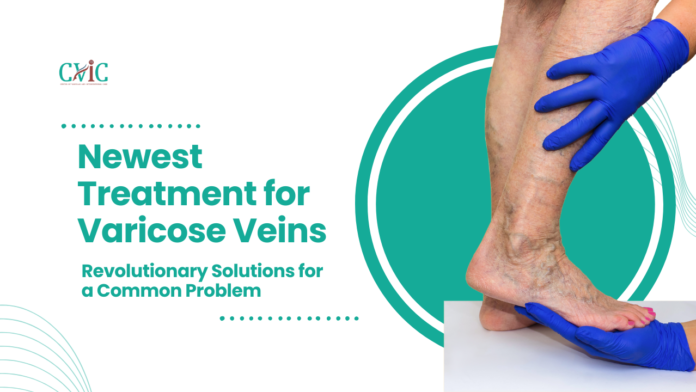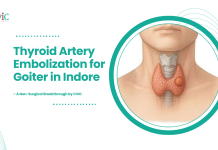Varicose veins have long been a source of discomfort, both physically and aesthetically, for many individuals. They are swollen, twisted veins that often appear on the legs and can cause pain, heaviness, and, in severe cases, more serious health issues. For years, the treatment of varicose veins involved invasive procedures like vein stripping, which required extensive recovery time and often resulted in significant discomfort. However, the medical landscape has evolved, and today, the newest treatment for varicose veins promises quicker recovery, less pain, and more effective results.
In this article, we’ll explore the latest advancements in varicose vein treatment, detailing the procedures, benefits, and considerations you should be aware of when seeking relief from this condition.
Understanding Varicose Veins
Varicose veins occur when veins become enlarged, dilated, and overfilled with blood. This happens when the valves in the veins, which are supposed to prevent blood from flowing backward, become weak or damaged. As a result, blood pools in the veins, causing them to swell and become varicose. These veins are often visible just under the skin and can be blue or dark purple in color.
While varicose veins can occur anywhere in the body, they are most commonly found on the legs due to the increased pressure in the lower body veins from standing and walking. Symptoms can range from mild discomfort and cosmetic concerns to more severe pain, swelling, and in some cases, skin ulcers.
Also Read: Comprehensive Guide to Varicose Veins: Causes, Symptoms, and Treatment Options

Traditional Treatments vs. Newest Treatment for Varicose Veins
Historically, treatments for varicose veins included options like compression stockings, sclerotherapy, and surgical vein stripping. While effective, these treatments often required long recovery times and could be painful. Surgical options, in particular, were invasive and required a hospital stay.
However, the newest treatment for varicose veins offers a stark contrast to these traditional methods. Modern treatments are minimally invasive, often performed on an outpatient basis, and allow for a much quicker return to normal activities. Let’s dive into some of these cutting-edge treatments that are transforming the way varicose veins are treated.
Endovenous Laser Treatment (EVLT)
Endovenous Laser Treatment (EVLT) is one of the most popular and effective new treatments for varicose veins. This procedure involves inserting a small laser fiber into the affected vein. The laser emits energy that heats the vein walls, causing them to collapse and seal shut. Over time, the sealed vein is reabsorbed by the body, and blood flow is redirected to healthier veins.
EVLT is performed under local anesthesia and typically takes less than an hour. Most patients can return to their regular activities within a day or two, making it a highly convenient option. The procedure is also highly effective, with a success rate of up to 98%.
Also Read: Laser Treatment for Varicose Veins: A Comprehensive Guide
Radiofrequency Ablation (RFA)
Similar to EVLT, Radiofrequency Ablation (RFA) is another minimally invasive technique used to treat varicose veins. Instead of laser energy, RFA uses radiofrequency energy to heat the vein walls, causing them to collapse and eventually be absorbed by the body.
RFA is also performed under local anesthesia and is usually completed in under an hour. Patients report minimal discomfort during and after the procedure, and like EVLT, recovery is quick, with most individuals resuming normal activities shortly after treatment. The success rates for RFA are also comparable to those of EVLT, making it another excellent option for treating varicose veins.
Vena Seal Closure System
The Closure System represents a truly innovative approach to the treatment of varicose veins. Unlike EVLT and RFA, which use heat to close off veins, Vena Seal uses a medical adhesive to seal the affected vein. During the procedure, a small catheter is inserted into the vein, and the adhesive is delivered through the catheter to seal the vein closed.
One of the key advantages of Vena Seal is that it doesn’t require tumescent anesthesia, which is needed for procedures involving heat. This reduces the risk of nerve injury and allows for a more comfortable experience. Additionally, Vena Seal typically requires only one small injection, making it a nearly painless option for patients. The recovery is swift, and many patients can return to their daily routines immediately after the procedure.
Also Read: Why Bulging Veins Pop Out on Your Hands: Causes and Solutions
Clarivein® (Mechanochemical Ablation)
Clarivein® is another exciting development in the treatment of varicose veins. This method combines two techniques—mechanical and chemical—to close off varicose veins. The procedure involves inserting a rotating catheter into the vein, which mechanically damages the vein’s inner lining. Simultaneously, a sclerosing agent (a chemical that irritates the vein) is delivered to cause the vein to collapse and seal shut.
Clarivein® is particularly beneficial for patients who may not be suitable candidates for thermal treatments like EVLT or RFA. The procedure is fast, minimally invasive, and requires no anesthesia, making it a convenient choice for many. Recovery is also rapid, with most patients resuming normal activities within 24 hours.
Ambulatory Phlebectomy
For patients with smaller varicose veins that are close to the surface of the skin, ambulatory phlebectomy may be an appropriate treatment. This procedure involves making tiny incisions through which the affected veins are removed. Unlike traditional vein stripping, ambulatory phlebectomy is minimally invasive and performed under local anesthesia.
The incisions are so small that stitches are not required, and scarring is minimal. Recovery time is short, and patients can typically return to normal activities within a few days. Ambulatory phlebectomy is an excellent option for treating smaller varicose veins that may not be suitable for other treatment methods.
Also Read: What is the Risk of Varicose Vein Ablation?
Compression Therapy as a Complement to the Newest Treatment for Varicose Veins
While modern treatments for varicose veins are highly effective, compression therapy remains a valuable complementary treatment. Compression stockings are often recommended after procedures like EVLT, RFA, or VenaSeal to support vein health and prevent the recurrence of varicose veins. These stockings help improve blood flow, reduce swelling, and alleviate symptoms of discomfort.
Choosing the Right Treatment for You
When considering the newest treatment for varicose veins, it’s essential to consult with a vascular specialist or a vein clinic to determine the best option for your specific condition. Factors such as the severity of your varicose veins, your overall health, and your personal preferences will all play a role in deciding which treatment is right for you.
Many of these treatments can be performed on an outpatient basis, and with advancements in medical technology, patients now have more choices than ever before. Whether you’re looking for a minimally invasive procedure, a treatment with minimal discomfort, or a quick recovery, the newest treatments for varicose veins offer solutions that can meet your needs.
Also Read: Varicose Vein Treatment: Endovenous Laser Therapy
Newest Treatment for Varicose Veins: Benefits and Considerations
The latest advancements in varicose vein treatment offer numerous benefits, but there are also some considerations to keep in mind.
Benefits:
- Minimally Invasive: Most new treatments are minimally invasive, meaning they involve tiny incisions or no incisions at all, leading to less scarring and quicker recovery times.
- Outpatient Procedures: These treatments are often performed in an outpatient setting, allowing patients to go home the same day.
- Quick Recovery: Patients can typically return to their normal activities within a few days, with minimal downtime required.
- High Success Rates: Procedures like EVLT and RFA boast success rates of over 95%, making them reliable options for treating varicose veins.
Considerations:
- Cost: Some of the newest treatments for varicose veins may not be covered by insurance, so it’s important to check with your provider about coverage and costs.
- Suitability: Not all patients are suitable candidates for every type of treatment. Factors such as vein size, location, and your overall health can influence which treatment is best for you.
- Side Effects: While rare, some treatments can have side effects such as bruising, swelling, or nerve injury. It’s important to discuss these potential risks with your doctor.
Conclusion
Varicose veins can be a source of discomfort and self-consciousness, but thanks to the newest treatment options, relief is more accessible and effective than ever before. These advanced, minimally invasive procedures offer significant benefits, including quicker recovery times, minimal pain, and high success rates. If you’re struggling with varicose veins, consulting with a vascular specialist about the latest treatment options could be the first step towards reclaiming your comfort and confidence.
Also Read: Top Vascular Center in MP – CVIC Indore

Frequently Asked Questions
What is the newest treatment for varicose veins?
The newest treatment for varicose veins includes advanced, minimally invasive procedures such as Endovenous Laser Treatment (EVLT), Radiofrequency Ablation (RFA), VenaSeal Closure System, Clarivein® (Mechanochemical Ablation), and Ambulatory Phlebectomy. These treatments offer quicker recovery, less pain, and high success rates.
How effective is the newest treatment for varicose veins?
The newest treatments, such as EVLT and RFA, have success rates of over 95%, making them highly effective for treating varicose veins.
Is the newest treatment for varicose veins painful?
Most of the newest treatments for varicose veins are minimally invasive and cause minimal discomfort. Procedures like VenaSeal and Clarivein® are nearly painless, and recovery is swift.
How long is the recovery time for the newest treatment for varicose veins?
Recovery time is typically very short, with most patients returning to their regular activities within a few days after treatment.
Are there any risks associated with the newest treatment for varicose veins?
While the newest treatments for varicose veins are generally safe, there are some risks, including bruising, swelling, and, in rare cases, nerve injury. It’s important to discuss these risks with your doctor before undergoing treatment.
Will the newest treatment for varicose veins be covered by insurance?
Coverage for varicose vein treatments varies by insurance provider. It’s important to check with your insurance company to see if the treatment you’re considering is covered.




